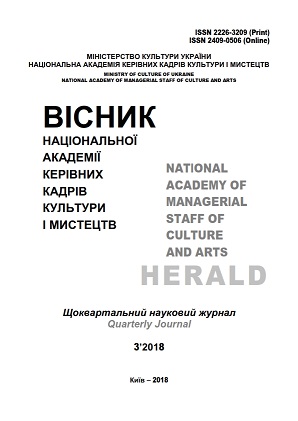Homo In Via: From the Plato’s Cave to the Modern Neuroscreen
Homo In Via: From the Plato’s Cave to the Modern Neuroscreen
Author(s): Viktor Vasylovych Karpov, Natalia Igorivna SyrotynskaSubject(s): Cultural history, Social Philosophy, Social history, Culture and social structure , Social development, Sociology of Culture, Ontology
Published by: Національна академія керівних кадрів культури і мистецтв
Keywords: Plato; cave allegory; Eidos; primitive culture; transgression; neuroscience; the reality of the neurоscreen;
Summary/Abstract: The purpose of the article is an interpretation of the famous Platonic myth about a cave from the perspective of the critical images rethinking in the context of their accentuation during the millennial development of the humankind culture as well as in acquiring the corresponding term for the designation of the modern style. Methodology. The choice of research strategies in identifying the features of changing key periods has determined the application of the systemic and integrated approach and contributed to the comprehension of value-based social and cultural imperatives within the historical development of humankind. The implementation of the semiotic and functional procedures is formed due to the identification of iconic connections between the symbols of the Platonic myth within the time-separated periods. The use of comparative and heuristic research methods helped to identify structural models reflecting the features of the functioning of culture at its various stages. Regarding the particular context, we use the prognostic aspect of the study, which involves understanding of new symbols that reflect social relations and cultural and artistic forms of modern information and technological civilization. The use of the mentioned methods of research contributed to obtaining their theoretical results. The scientific novelty of the study lies in the formulation and development of an actual topic, which within the scientific dimension has not received comprehensive and objective coverage and is being investigated for the first time. The research proves the idea that consists in the fact that the results of understanding of the images of the Platonic myth serve to build a new reading of the ways of development of human civilization, as well as to determine the value-based categories of the modern hyper-informational society. Conclusions. The development of the human culture demonstrates a tangible link of contemporary worldview landmarks with unique opportunities for technical innovation, which requires the introduction of new terminology. Also, it is noted that the Platonic myth of the cave arises with the appropriate marker, the polysemy of which made it possible to identify critical moments of the historical and cultural development of humankind and formulate appropriate definitions. The neuro art term is proposed which accumulates modern artistic means, reflected in a combination of unique expressive possibilities of sound, image, and text, which project a particular idea into the human subconscious with the help of various means of modern technology. Thus, a new reality of human existence arises - neuroscreens with the domination of political and economic interests, activating manipulative schemes based on eidetic means of representativeness. It is stated that the Platonic eidos discovers internal versatility, is the categorical structure of medieval and modern philosophers, correlates the artistic, historical processes of different periods, and therefore fully corresponds to the definition of contemporary style as eidetic.
Journal: Вісник Національної академії керівних кадрів культури і мистецтв
- Issue Year: 2018
- Issue No: 3
- Page Range: 19-26
- Page Count: 8
- Language: English

